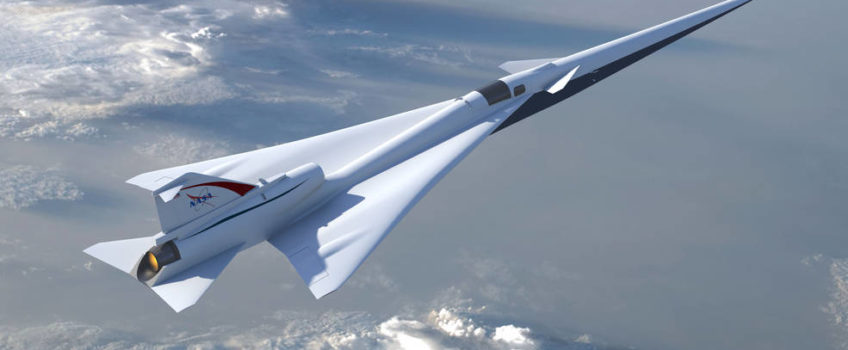
Aviation and aerospace technology has been at the forefront since the Concorde but now, there’s this. A supersonic jet that could travel at 1513 km/h (940 mph) considerably shortening commercial flight times. NASA has signed a deal with Lockheed Martin to develop a supersonic “X-plane” that could break the sound barrier but with one major difference – no sonic boom.
Refining and Redeveloping The Supersonic Jet
For the first time since Concorde-like crafts made headlines, NASA and Lockheed Martin combine to build a piloted experimental plane from the ground up. NASA wants to refine, build and test the experimental X-plane (experimental aircraft) to produce sonic booms barely audible from the ground.
Research and development include several studies detailing techniques to understand supersonic shock wave behaviour and how it relates to wing layout. According to NASA, even a 150-year-old photographic technique is helping researchers and engineers understand how supersonic shock waves function.
Based on preliminary designs from Lockheed Martin, the experimental supersonic jet will be 29 meters long with a 9 meter wingspan. The fully fueled take-off weight is said to be 15 tons and will cruise at 55 000 ft (16 764 meters). A General Electric F414 engine will power the aircraft, same as in the F/A-18E/F fighters. A single pilot will be in the cockpit which is based on the design of the rear cockpit seat of the T-38 training jet used for astronauts.
NASA plans to fly the experimental supersonic jet over six US cities between 2022 and 2025. The goal is to collect community responses and technical data that could greatly benefit supersonic passenger air travel. It could take us to the next level of supersonic passenger air transport.
The Science Behind The Silence
Noise levels have always been an obstacle for supersonic travel over land and therein lies the challenge for aeronautical innovators. It even proved too much for the Concorde which ultimately reduced its appeal to commercial airlines. So how do you build a silent supersonic jet?
The secret behind the quieter supersonic jet lies in the design. Its uniquely-shaped structure considerably reduces the sonic boom intensity creating a sound similar to that of a car door closing. Shock waves from a conventional aircraft design join forces as they expand away from the craft’s nose and tail resulting in two distinct and thunderous sonic booms. The new shape sends those shock waves away from the airplane in such a way that they don’t generate two loud booms. Instead, the weaker shock waves reach the ground individually and sound like a short series of soft thuds.
According to a NASA spokesperson, “The goal is to enable quieter supersonic flight and create new commercial cargo and passenger markets in faster-than-sound air travel”. For the time being, no passenger seats are in development. The project is all about first proving that the experimental supersonic jet can fly quietly. If that proves a success, the next step is to change the rules of the Federal Aviation Administration. Primarily to lift the ban on commercial supersonic flights over land since Concorde.
Low-Boom Flight Demonstration Conclusion
NASA is confident that the Low-Boom Flight Demonstration design will be a success. It’s been further buoyed by more positive results from recent wind tunnel testing, advanced computer simulations and actual flight testing.
Jetliners will be twice as fast as our modern day advanced airliners flying faster than the speed of sound. It will cut transcontinental travel times in half with initial ticket prices similar to first-class.
Would you get on the first production supersonic jet? If you’re a commercial pilot, how does this really compare to current airliners?
Please share your thoughts in the comment section below. You can also find us on Twitter, Facebook, YouTube, Google+ or LinkedIn. Remember to use our new hashtag #PRVtech in all your comments. Get in touch if you have any questions or if you need assistance with your engineering and manufacturing projects.
This site uses Akismet to reduce spam. Learn how your comment data is processed.


 Mail:
Mail: 




Leave a Comments